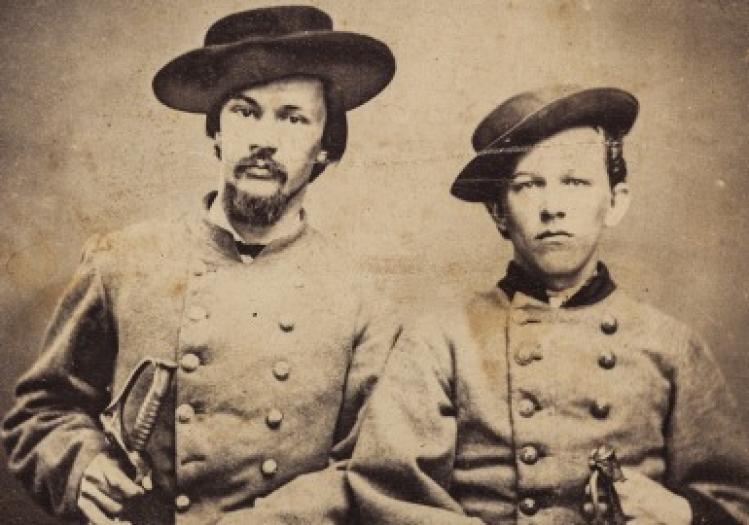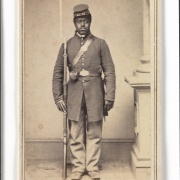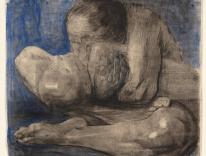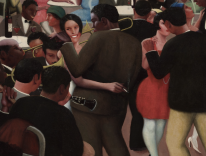
On May 10, 1905, my great-great-grandfather—a Civil War veteran, a former U.S. congressman, and at that time a federal judge—gave an address at the laying of the cornerstone of a monument to the Confederate dead in his hometown of Chester, South Carolina. He reflected on the Civil War that was then forty years past, a conflict in which he had lost his left arm. Recalling the comrades who had fought with him, he observed, “The pen of history can only record its larger events.... The spirit of an epoch, its true atmosphere, can be gathered only from the actions and incidents in the lives of individuals, often obscure and generally unknown to fame.”
The exhibit “Photography and the American Civil War” beautifully expresses the spirit of that epoch. Organized by New York’s Metropolitan Museum of Art, where it opened, the exhibit was on view at the Gibbes Museum of Art in Charleston, South Carolina, until January 5 and will be at the New Orleans Museum of Art from January 31 to May 4. With more than two hundred items, this powerful and exhausting show constitutes a record of those obscure and often unnamed individuals, documented through the then-new medium of photography.
In an age of image saturation, when Snapchat, Twitter, and Instagram transmit photographs around the world in seconds, it takes an act of the will to place oneself in a time when photography was in its infancy, a new artistic form of astonishing power. And while the images would be stunning in any museum, there is a special poignancy to their display in the city where the Civil War began.
During the course of that war, hundreds of photographers produced hundreds of thousands of photographs: body-strewn battlefields, carefully documented medical studies, and small portraits of individual soldiers. The curators invest the breadth and depth of the collection with a rare unifying power: “The creation of this vast treasury did something the opposing armies and their leaders could not: it defined, and perhaps even helped to unify, the nation via an unrehearsed and unscripted act of collective memory-making.”
Photographers in both the North and the South worked separately and in teams to document the war; they included well-known artists such as Mathew Brady and his protégé (and ultimately his rival) Alexander Gardner, as well as many unknown photographers. The photographs of landscapes and battlefields range from Gettysburg to Bull Run; the human subjects span the spectrum of soldiers and sailors, doctors and politicians, women and children, and former slaves, whose slow march toward freedom is documented through such images as an 1865 portrait of Private Louis Troutman of the U.S. Colored Infantry (at left), annotated on the verso side to read: “Sharp & will soon be a non-commissioned officer.” Each photograph commands our attention, reflecting a different aspect of a tragic and complicated conflict.
To the cell-phone-camera artist of our time, it is difficult to comprehend the daunting challenges of cumbersome equipment, rough terrain, and complicated photographic processes that faced the battlefield photographer. Despite these barriers (vividly embodied in the display of Mathew Brady’s clunky studio camera on its heavy tripod), intrepid photographers managed to convey, if not the chaos of action, at least some of the dramatic landscape of war. A rare panoramic view of the Pennsylvania Light Artillery near Petersburg, with its speckled shadows and gentle gradations of light, its dark figures in suspended motion and its ghostly cannon; a slave dealer’s storefront in Alexandria, which became a prison for captured Confederate soldiers; the charred ruins of the Gallego Flour Mill outside of Richmond, an icon of the South’s defeat; photographs of Fort Sumter taken just days after the Confederate assault—all these constitute a visual poetry of the war. Its violence is captured, too, in such famous photographs as Alexander Gardner’s “A Harvest of Death,” which portrays stiffened bodies littering the fields of Gettysburg.
Also on view is another of Gardner’s photographs, the controversial “Home of a Rebel Sharpshooter,” which shows a dead Confederate soldier splayed out behind a rocky embankment with a gun by his hand. Not only was the photograph staged with props (the weapon in question is a musket, not a sniper’s rifle), but it is likely that the body itself was moved and repositioned, since, in another image, the same corpse appears in a field. While we are decades away from the “quick fixes, creative enhancements, and endless fun” promised by Photoshop, already the camera’s capacity to manipulate reality is abundantly evident.
While the landscapes and battlefields leave their impression, the most searing truths about the war are to be found in the faces of its people. The stars of this exhibit are the portraits. Confederate and Union, slave and free, prominent and unknown, they are, as my great-great-grandfather knew, the “little rills that go to make the larger stream.” The images, or “shadows,” of these individuals were created through a variety of photographic processes as artists experimented with the new medium. Although the exhibit displays some relatively large portraits, including four imposing hand-colored albumen silver prints of Union soldiers commissioned in 1866 by the Quartermaster General of the United States Army, it is the constellation of miniatures that captures in most vivid detail the human element of the war.
These small portraits—of soldiers going off to war, and of the families left behind—were placed lovingly in lockets, housed in small brass cases, or tucked into uniform pockets. To family members at home, they were perhaps seen as talismans against the death of a beloved brother, father, or uncle, or as placeholders for memory, in case the portrait sitter did not survive. To a soldier facing battle, a miniature portrait of his children or his wife was a comforting reminder of what he was fighting for. They are witnesses to the strong belief in the power of the image. They are also, as the curators note, “masterpieces of vernacular picture-making.” And they are heartbreaking—a nineteenth-century Facebook of the dead.
THE CHEAPEST AND MOST portable photographs were known as cartes de visites (the French term for “calling card”). Roughly the size of baseball cards (4 ¼ x 2 ½ inches), these photographic prints usually depicted a person or a small group. The first photo albums in the country were created to hold them: such albums might contain portraits of presidents (Lincoln and Jefferson Davis) and generals (Grant and Lee) as well as family members gone off to fight. Soldiers would carry small leather-bound pocket albums that accommodated multiple cards; there are several such albums on display.
 Because they were inexpensive to create and easy to disseminate, the cartes de visite proved to be useful in a variety of ways. There is the striking photograph of Sojourner Truth on a carte de visite, titled “I Sell the Shadow to Support the Substance”; here, the abolitionist, feminist, and former slave markets her image, or “shadow,” for the benefit of her causes. Down the wall is the terrible image of “Gordon,” a runaway slave from a Mississippi river plantation whose scourged back is covered with scarred wounds and welts. Farther along in the exhibit is a full case of cards of African Americans: freed slaves who became Union soldiers, formerly enslaved children who are learning to read. A card that was particularly popular with soldiers toward the war’s end depicted Frances Clayton, a woman who disguised herself as a man to serve in the Union army. She poses as Jack Williams, her left leg crossed jauntily across her right knee and the sword held—pointedly, as it were—between her legs.
Because they were inexpensive to create and easy to disseminate, the cartes de visite proved to be useful in a variety of ways. There is the striking photograph of Sojourner Truth on a carte de visite, titled “I Sell the Shadow to Support the Substance”; here, the abolitionist, feminist, and former slave markets her image, or “shadow,” for the benefit of her causes. Down the wall is the terrible image of “Gordon,” a runaway slave from a Mississippi river plantation whose scourged back is covered with scarred wounds and welts. Farther along in the exhibit is a full case of cards of African Americans: freed slaves who became Union soldiers, formerly enslaved children who are learning to read. A card that was particularly popular with soldiers toward the war’s end depicted Frances Clayton, a woman who disguised herself as a man to serve in the Union army. She poses as Jack Williams, her left leg crossed jauntily across her right knee and the sword held—pointedly, as it were—between her legs.
The genre was a handy tool for political satire, too. An 1863 card portrays Lincoln holding a banjo, singing “I Wish I Was in Dixie.” Nearby is a caricature of Jefferson Davis from 1865, humiliatingly dressed in woman’s clothing at the time of his capture by the Fourth Michigan Cavalry, with a caption reading “How Do You Like It, Jefferson D?”
After the war, amputees often relied on the sale of cartes de visite for their survival: Alfred Stratton, a Union soldier who lost both his arms at Petersburg, was unable to return to his trade as a blacksmith, and sold his image to generate what meager income he could for his family. In a woeful photo, he stares despairingly into the camera, his truncated arms hanging at his side; the caption informs us that he died within a few years of complications from his wounds. The first photographs ever to appear in a “wanted” poster were cartes de visite: the broadside for the capture of John Wilkes Booth and two accomplices in the assassination of Lincoln displayed their cartes de visite portraits at the top of the poster.
Ambrotype and tintype portraits were slightly more durable than the paper cards. Tintypes (a misnomer: they were made of iron) were particularly popular, because they were lightweight, low-cost, and easily mailed. Unlike the cartes de visite, which were black and white, the majority of these portraits have applied color—a bit of rouge on the cheeks, a dab of gold on the buttons. Many were housed in brass cases or small portrait frames. Not far from where the image of the scarred slave Gordon hangs, for example, is a small ambrotype in a portrait case. It shows two brothers, Charles and John Hawkins, who signed on with the 38th Regiment of the Georgia Volunteer Infantry. Charles died under Lee’s command in the Shenandoah Valley; John would survive Appomattox. In the photograph, both boys’ hands rest at the ready atop their swords. The older brother, on the left, looks feistily at the camera; the younger, on the right, seems a bit taken aback by it all. They are hauntingly real; as I gazed at them, I could not help thinking that, but for the span of a hundred and fifty years, they could have been my two oldest sons.
There are scores of such portraits. The faces are grim, haunted, confident, resolute, sad. The four bearded Pattillo brothers, brandishing Bowie knives, look as if they’ve wandered in from the set of Duck Dynasty. Elsewhere, a ghostly, over-exposed Union soldier stands in a light cape, his eyes eerily radiant. An image by A. J. Riddle of an emaciated soldier rescued from Andersonville is accompanied by Walt Whitman’s searing condemnation of that notorious prison camp. And there is the melancholy portrait of Robert E. Lee, taken days after his surrender; his hat held at his side, he stares pensively into the distance, wondering what might have been.
An especially moving image depicts three young children. Titled “Frank, Frederick & Alice,” it was clutched in the hand of an otherwise unidentified dead Union soldier at Gettysburg. After the photograph appeared in the Philadelphia Inquirer with the caption “Whose Father Was He?” the orphaned children and their widowed mother, Philinda Humiston, were located and given assistance. Eventually they moved into the National Homestead for Widows and Orphans that opened in Gettysburg in 1866, its establishment spurred to no small extent by photographs like this one. These small children embody the real human cost of the war for both sides.
And so perhaps the curators are on to something in seeing the medium of photography as conferring a unity upon the Civil War experience. In these photographs of seasoned veterans, jaunty privates, newly emancipated slaves, and small children, the personal dignity of each individual stands out. Political allegiance, geographic location, and skin color aside, their faces radiate a common humanity. While historians may continue to debate the economic factors, political influences, and proximate causes of the war, these photographs reflect why the war was fought: to establish the equal dignity of each human person.
For four terrible years that common humanity was forgotten. A century and a half later, in our own politically fractured time, we seem to be forgetting it again, frenziedly focused on what divides rather than what binds us together as a people. But as my great-great-grandfather noted four decades after the war, healing unity is always possible: “It is the everlasting glory of the American people,” he told his audience in Chester, “that within a half-century of the close of the most bitter and deadly contest they are more united now than ever before, nearer to that ‘perfect Union’ designed by the fathers, every part vying with the other in devotion to a common country and pride in its great destiny.”
Please email comments to [email protected] and join the conversation on our Facebook page.
Previous Story
Voracious
Next Story
Alternative Medicine


